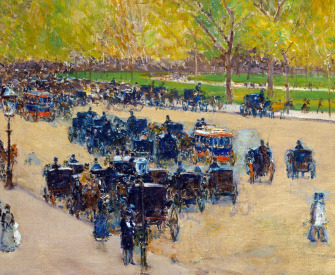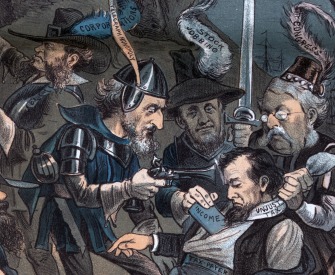When night comes upon the town, city lights begin to twinkle. At the first soft breath of twilight, windows in the office buildings become radiant, storefronts blaze forth in brilliancy, shades are quickly drawn in all the quiet homes—behind them more lights warmly glow. Twilight gives birth to night, and then the streetlights burst into life. There is variety in these. The surface cars that toil along the public ways, crowded with homebound humanity, are as gayly brilliant as a king’s palace one hundred years ago—we do progress in a century. Any well-born citizen of 1810 might rub his eyes in wonder—the cold white iridescence of a myriad sputtering arcs makes the city street at night as brilliant as midday. The birdman, skimming the low skies in the mechanical marvel that the twentieth century gave him, sees, from his perch aloft, the city outlined as clearly by night as by day.
Electricity is the nerve force of the modern city; gas may possibly be likened to its pulsing blood. Electricity, as used in a city for lighting and for transportation by railroad, comes from several great powerhouses, usually spread along the waterfront—the veritable ganglia of this vast nerve force. From these lead a multiplicity of cables and conduits—call these the nerves of the city, if it so pleases you—through smaller ganglia, which your engineer is content to know as substations or transforming stations. Gas alone comes from several stations—fire risk is greatly reduced by spreading these widely about town. In any large city it is impossible to conceive today of a fire—short of a holocaust—being able to bring the absolute dark of night upon it. That is one of the solved problems of lighting.
Modern city development, acting under the pressure of economic necessity, has been chary of wide, light spaces. So the great skyscrapers elbow one another far too closely; street widths and air shafts are narrowed proportionately. The result of this has been a greater demand each year for all-day lighting, and some considerable needs are cast upon the gas and electric companies, even on the brightest of midsummer days. These needs increase gradually as winter approaches, rapidly under stress of rain or fog or snow.
A summer’s thunderstorm or a winter’s fog blows quickly down upon the town. Thousands of hands reach almost simultaneously for the light. A great strain is instantly created upon lighting facilities. This demand does not find the lighting companies unprepared. In days of old, watchers were stationed upon the high housetops of medieval cities to give warning of the coming of an unexpected foe. In these days there are watchers upon the high housetops of the modern city. They go there whenever the barometer begins to spell uncertainty. With powerful glasses they skim the distant corners of the horizon. A distant black cloud—a seemingly harmless thing in the faraway sky, but a thing of magnificent potentialities close at hand—is seen. Its approach is closely noted.
The watcher of the skies gives quick warning over the telephone. The drone of lazy midday ceases instantly. Men come out of their drowsy catnaps. They rush to their positions, fresh fuel goes upon a hundred banked boilers; in the powerhouse ganglia, the chief operator, who is king of the situation, orders additional engines and generators into service; stored current, like stored gas, is turned into the mains. When the black clouds finally rest above the town and the myriad hands are reaching for the desk lights, the strain has already been met. The light, be it gas or be it electricity, burns as steadily and as brightly as it burned five minutes before, when less than one-fifth the quantity was the demand.
By four o’clock of a winter’s night, the lighting companies begin to feel the added strain. They are prepared for this; engines, generators, retorts, and men, held in reserve throughout the dull hours of the day, go into service on schedule. The demand rapidly increases for an hour; by five o’clock they are at the peak of the load. This means that every man, every machine, must work at fullest capacity, under sharpest tension, while it lasts. Men and machinery under almost superhuman efforts carry the peak load forward and pray that there will be no breakdown.
Before six o’clock they are off the peak. Business offices downtown in the skyscrapers are beginning to close for the night. When they go out, and the last of the hotel and restaurant lights sleepily blink good night, the load has dipped to its lowest degree. Streetlamps, a comparatively few building lights that never drop off to sleep, some current for the morning newspapers—all of these do not require as much as midday of the brightest day of the year. After all, a great city does almost sleep at nightfall.
From “The Night-Glow of the City.” Hungerford worked as a business journalist, writing for periodicals including Harper’s Weekly, where this article ran. He reported extensively on private railroad companies. “The railroad is a monster,” he wrote in 1909. “His arms stretch through the towns and over the land…The railroad is life itself!” In this article, Hungerford interviewed the chief operator of New York City’s power stations, comparing him to a train dispatcher mapping the city’s “hidden conduits and cables, as clearly as a railroad is mapped.”
Back to Issue



